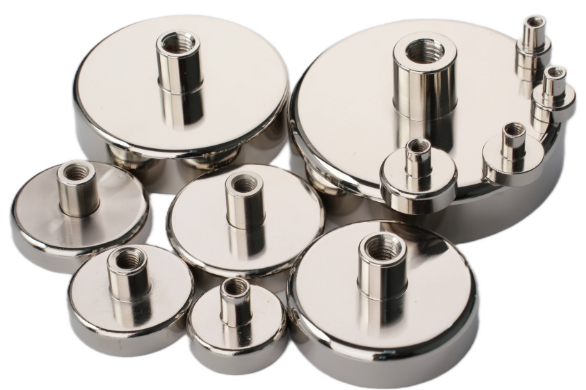Enhancing Neodymium Magnets with PTFE Coating: Properties and Applications
Introduction
Neodymium magnets are renowned for their exceptional strength and versatility in various applications. When paired with a polytetrafluoroethylene (PTFE) coating, these magnets become even more powerful and adaptable. In this article, we'll explore the properties of PTFE-coated neodymium magnets and delve into their wide-ranging applications across different industries.
The Science behind Neodymium Magnets
Neodymium magnets, often referred to as NdFeB magnets, are composed of neodymium, iron, and boron. This unique combination results in magnets that possess the strongest magnetic properties available today. Their high magnetic flux density, excellent coercivity, and magnetic stability make them ideal candidates for numerous applications. 
Empowering Neodymium Magnets with PTFE Coating
Polytetrafluoroethylene (PTFE) is a synthetic fluoropolymer known for its exceptional non-stick properties, chemical resistance, and low friction coefficient. When neodymium magnets are coated with a layer of PTFE, it introduces a range of advantages:
1. Enhanced Durability:
PTFE provides a protective shield to neodymium magnets, safeguarding them from environmental factors like moisture and corrosion. This enhanced durability extends the magnet's lifespan, reducing maintenance and replacement costs.
2. Reduced Friction:
The low friction coefficient of PTFE-coated neodymium magnets enables smooth movement and rotation. This property is especially valuable in applications where minimal friction is essential, such as conveyor systems and magnetic couplings.
3. Chemical Resistance:
PTFE is highly resistant to various chemicals and solvents. This resistance allows PTFE-coated neodymium magnets to perform reliably in harsh chemical environments without degradation. Related reading: Precision and Protection: The Magic of Neodymium Magnets Enhanced by Teflon Coating
Exploring Applications
PTFE-coated neodymium magnets find application across diverse industries due to their unique properties:
1. Magnetic Couplings:
In industries where fluid containment is critical, such as chemical processing and water treatment, PTFE-coated neodymium magnets are used in magnetic couplings. These couplings enable a hermetic seal without physical contact, preventing contamination and leakages.
2. Conveyor Systems:
Conveyor systems benefit from the reduced wear and tear provided by PTFE-coated neodymium magnets. Their low friction properties contribute to smoother material handling, improving the efficiency and longevity of conveyor belts.
3. Pumps and Motors:
These magnets are integral components in high-performance pumps and motors. Their strong magnetic force ensures efficient fluid handling in applications ranging from medical devices to automotive systems.
4. Magnetic Stirrers:
Laboratories and chemical industries rely on PTFE-coated neodymium magnets for precise and consistent stirring. Reduced friction and wear make them ideal for maintaining the integrity of sensitive mixtures and reactions.
5. Separation and Filtration:
In separation and filtration processes, these magnets capture ferrous contaminants effectively. Their powerful magnetic fields attract and retain unwanted particles, ensuring cleaner end products in industries like food and pharmaceuticals.
6. Aerospace Applications:
PTFE-coated neodymium magnets play a crucial role in aerospace technology. Their lightweight yet powerful magnetic properties make them ideal for various aerospace applications. They are used in components like actuators, sensors, and deployment systems for their ability to withstand extreme conditions while providing precise control and reliability. These magnets contribute to the efficiency and safety of aerospace equipment.
7. Renewable Energy Generation:
With the growing emphasis on renewable energy sources like wind and hydroelectric power, PTFE-coated neodymium magnets find application in generators and turbines. Their low friction and high magnetic strength allow for efficient energy conversion, contributing to the generation of clean and sustainable electricity.
8. Automotive Industry:
In the automotive sector, PTFE-coated neodymium magnets are used in various applications, including electric vehicle (EV) technology. They are employed in EV motors and power steering systems, enhancing their performance and efficiency. As the automotive industry continues to transition toward electrification, these magnets are poised to play a pivotal role in the advancement of electric vehicle technology.
9. Biomedical Devices:
PTFE-coated neodymium magnets are also finding their way into biomedical devices and medical research. They are used in magnetic resonance imaging (MRI) machines, where their precise and consistent magnetic properties contribute to high-quality imaging. Additionally, in research settings, these magnets are employed in experiments involving magnetic fields and the manipulation of biological samples.
Conclusion
In a word, the versatile and robust nature of PTFE-coated neodymium magnets extends their applicability across a wide spectrum of industries. Their ability to enhance performance, reduce wear and friction, and resist environmental factors positions them as indispensable components in the modern technological landscape. As innovation continues to drive these industries forward, PTFE-coated neodymium magnets are poised to play an increasingly vital role in shaping the future of technology and industry. Stanford Magnets offers quality PTFE-coated magnets. If you're interested, please don't hesitate to send us an inquiry.















